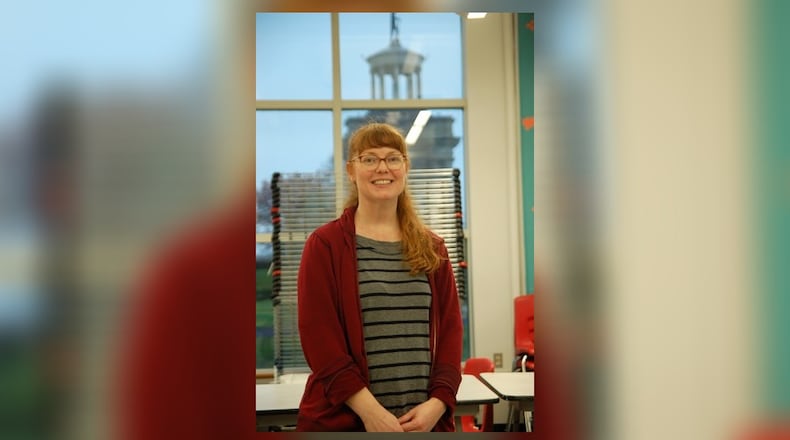Collopy will create a series of five to 10 acrylic-on-linen paintings during her residency titled “You Are NOT What You Eat,” specifically still-life paintings of the food often consumed by disadvantaged people. Think of convenient and affordable items like generic brands, spoiled fruits and vegetables sold at a discount or fast food.
“The feeling of hunger and the dependency on government subsidies was the norm in my family. I always had the blue lunch ticket, different than the yellow of my fellow classmates,” said Collopy.
Collopy, who teaches a Creative Aging Painting Class at the Fitton Center, began her three-month residency on April 1. The position will run through the end of June.
Question: Tell us about yourself.
Chrissy Collopy: I live in Darrtown. I’m a regional artist. I went to Miami University for a few years and studied in the Fine Arts program. After that I worked in several art organizations. So, I’ve been involved in the art world for a while. I worked at Bill’s Art Store in Uptown Oxford. He’s no longer with us, and his store is no longer there, but he taught me a lot. I was basically his apprentice, learning about art materials and selling art materials as well as matting and framing. He taught me a lot about painting. Then, I worked at the Oxford Community Arts Center as the gallery curator for several years. While I was doing that, I also started working with Opening Minds Through Art, which is a program that works with people who have dementia, and it engages them in art-making … I dove into the arts community. I’m very thankful and lucky to have all the opportunities that were given to me just based on the work that I’ve done.
Q: How long have you been teaching at the Fitton Center?
A: I started teaching at the Fitton Center in the winter of 2015, so it’s going on nine years now. I’ve enjoyed every minute of it. I teach Creative Aging Acrylic Painting classes. I’ve also done some community outreach programs with them.
Q: Why were you interested in the artist-in-residence program, and why did you want to be a part of it?
A: When I read about the artist-in-residence, I thought to myself: ‘I have a connection, because I have experienced food insufficiency and hunger when I was younger. My family grew up in poverty. I haven’t done a residency before, and I haven’t had the opportunity to do so.’ With my experience, I felt like it was a good chance to bring together the mission of the Fitton Center and SOS Art. I also wanted to be engaged with something that was part of the larger community and connect with people in that way.
Q: Why do you feel is it important to draw attention to food insufficiency and hunger?
A: If you’re hungry and you’re not able to have the sustenance to live your life, it’s not easy to be productive and contribute to society. If you’re always thinking about food, and not having it, how are you able to think outside of yourself? Food is what fuels your body, and you need to eat. So, to me, the peace and justice piece is making sure that people have that food. As a community, we only come up together if we’re all the best we can be, and food is the number one thing that we need to live. If we can somehow make people aware of the conditions that we live in, hopefully, it can make a difference. In Ohio, there’s over one million people hungry, and over 380,000 of those are children. So, there are people out there who can’t even go to school, or get a job, and concentrate because they’re hungry.
Q: How will you tie the theme of food insufficiency and hunger into your artwork?
A: Immediately, I was having visions of what I wanted to paint, and how I can connect to it visually. So, with these paintings, I want to be able to connect in a way that’s personal. There are all different kinds of hunger in the world. There’s hunger from poverty. There’s hunger from war. So, there’s different aspects of hunger. I thought, I have to make it personal to be able to connect with it as well as to connect with other people. I will be creating still-life paintings of foods that I ate when I was younger. That may be considered healthy, or maybe there wasn’t food available, so this is what I ate at the time. I’m making these still life paintings, and I hope people connect in that same way. For me, it takes away the shame that you feel when you don’t have the foods that people have more access to, like healthy vegetables and fruit. You have what you have, and you have to eat. So, if it’s a box of mac and cheese, you throw it together, and that’s what you have for dinner.
How to go
The first public viewing of the paintings will be held on May 28, World Hunger Day, at the Mount Auburn Presbyterian Church (103 William Howard Taft Road, Cincinnati).
Collopy’s “You Are NOT What You Eat” paintings, as well as pieces by the collage workshop participants, will appear in an exhibition in the Community Gallery at the Fitton Center from June 6 through June 30. Guests are invited to bring non-perishable food items, which will be donated to area food banks.
Additionally, Collopy has several collage pieces in the Fitton Center’s 30th Anniversary Member Show, which will run through July 12.
About the Author
